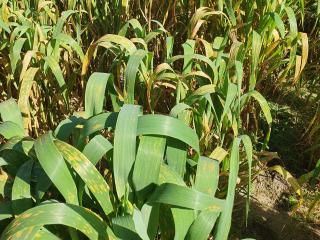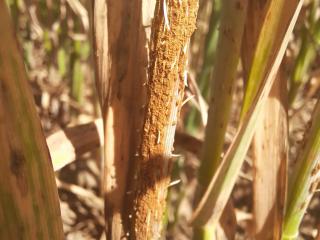Check susceptible oat crops for leaf and stem rusts
- Geraldton
- Lakes district
- Grass Patch
- Esperance port zone
Plant pathologist Ciara Beard (DPIRD) reports finding leaf rust in wild oats and oat regrowth in the Geraldton district.
Trent Butcher (ConsultAg) has reported that he is starting to find stem rust in Wandering and Carrolup oats around the Lakes districts. Leaf rust is also present in Williams oats but is not aggressively spreading. Crops are at flag leaf to 50% heading and growers are looking to spray paddocks now.
Plant pathologist Andrea Hills (DPIRD) reports that leaf rust is on wild oats throughout the Esperance port zone. Stem rust has also been reported in wild oats at Grass Patch.
Monitoring of oat crops for rust at this time of year is important, especially for susceptible varieties that have not received any fungicide application. While many varieties have some resistance to common leaf rust pathotypes in WA, resistance to stem rust is poorer in many varieties.
Rust spores can be spread long distances by wind and with rust infection in wild oats being widespread this season the disease risk is significant in many regions. Stem rust thrives in warmer conditions than leaf rust and is usually detected later in the season (mid-spring) so continued monitoring of susceptible varieties is recommended into early grain fill.
When monitoring for stem rust look for large, elongated pustules full of dark reddish-brown powdery spores on stems and leaf sheaths, leaves (both sides) and sometimes on heads. The leaf surface at the edge of a stem rust pustule is often ruptured with a tattered edge.
Managing rusts in oats
Leaf and stem rust can cause significant yield and quality downgrades in both grain and hay production systems, particularly in susceptible varieties. For both leaf and stem rust, multiplication and spread of infection is extremely rapid in susceptible and very susceptible varieties and an immediate application of a registered fungicide is recommended for crops at flag leaf and booting.
To check your oat crops variety susceptibility rating refer to DPIRD’s 2021 WA Crop Sowing Guide.
For a list of registered fungicides to use as foliar sprays on cereal crops visit DPIRD’s Registered foliar fungicides for cereals in Western Australia page. Check and observe fungicide labels for withholding periods for export hay cutting.
Samples of rusts can be sent for pathotype testing. Infected leaf samples should be mailed in paper envelopes (do not use plastic wrapping or plastic lined packages) along with your details and collection information (location, variety etc.) directly to The University of Sydney, Australian Rust Survey, Reply Paid 88076, Narellan NSW 2567. Free reply paid envelopes can be ordered from University of Sydney.
For further details see the University of Sydney's Australian Cereal Rust Survey page.
For previous oat rust reports this season refer to DPIRD’s 2021 PestFax Issue 13 article Stem rust in volunteer oats and Issue 10 article Bacterial blight, Septoria avenae blotch and leaf rust are appearing in oats.
For further information on rusts in oats refer to DPIRD’s Diagnosing stem rust in oats and Oats: leaf diseases pages.
For more information contact Plant Pathologists Kylie Chambers, Northam on +61 (0)8 9690 2151, Geoff Thomas, South Perth on +61 (0)8 9368 3982 or Kithsiri Jayasena, Albany on +61 (0)8 9892 8477.
Article authors: Geoff Thomas (DPIRD South Perth), Kithsiri Jayasena (DPIRD Albany) and Cindy Webster (DPIRD Narrogin).
Article input: Kylie Chambers (DPIRD Northam).


